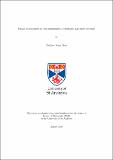Files in this item
Phase transitions in two-dimensional itinerant electron systems
Item metadata
| dc.contributor.advisor | Hooley, Chris | |
| dc.contributor.author | Trott, Matthew J. | |
| dc.coverage.spatial | ix, 98 p. | en_US |
| dc.date.accessioned | 2020-12-07T11:04:03Z | |
| dc.date.available | 2020-12-07T11:04:03Z | |
| dc.date.issued | 2020-12-01 | |
| dc.identifier.uri | https://hdl.handle.net/10023/21052 | |
| dc.description.abstract | The aim of this thesis it to contribute to three open problems in the theory of itinerant electron systems in two spatial dimensions. Firstly, the mechanism for charge density wave formation in the transition metal dichalcogenides is a debated subject. In this thesis it is shown that charge density wave formation is possible via a purely electronic mechanism in monolayer vanadium diselenide. The competition of superconductivity and density wave formation is taken into account using the renormalisation group. As the Fermi surface is tuned to perfect nesting, a charge density wave phase emerges when the Heisenberg exchange interaction is of the order of the contact Coulomb repulsion. Secondly, the search for materials which exhibit topological superconductivity is ongoing. Possible candidates are strongly spin-orbit-coupled metals. In this thesis a square-lattice Hubbard model with strong Rashba spin-orbit coupling and one of the Fermi surfaces close to a Lifshitz transition is examined. The metal is shown to be generically unstable to the formation of mixed-parity superconductivity with a helical triplet component via a renormalisation group analysis. Thirdly, the breakdown of Fermi liquid theory close to a quantum critical point is still not well understood. In this thesis a functional renormalisation group analysis is presented using a soft frequency cutoff, investigating a general class of Pomeranchuk instabilities with 𝑁[sub]𝑏 flavours of boson. At small 𝑁[sub]𝑏 the theory is characterised by weakly non-Fermi-liquid behaviour of the electrons and 𝑧≈2 dynamics for the order parameter fluctuations. For large 𝑁[sub]𝑏, the theory crosses over to 𝑧≈1 scaling and non-Fermi-liquid behaviour. | en_US |
| dc.description.sponsorship | "The work in this thesis was supported by the Engineering and Physical Sciences Research Council (UK) Centre for Doctoral Training in Condensed Matter Physics [grant number EP/L015110/1]." -- Acknowledgements | en |
| dc.language.iso | en | en_US |
| dc.publisher | University of St Andrews | |
| dc.rights | Creative Commons Attribution-NonCommercial-NoDerivatives 4.0 International | * |
| dc.rights.uri | http://creativecommons.org/licenses/by-nc-nd/4.0/ | * |
| dc.subject | Condensed matter physics | en_US |
| dc.subject | Phase transitions | en_US |
| dc.subject | Renormalisation group | en_US |
| dc.subject | Strongly correlated electrons | en_US |
| dc.subject | Superconductivity | en_US |
| dc.subject | Charge density waves | en_US |
| dc.subject.lcc | QC173.458E43T8 | |
| dc.subject.lcsh | Condensed matter | en |
| dc.subject.lcsh | Phase transformations (Statistical physics) | en |
| dc.subject.lcsh | Renormalisation group | en |
| dc.subject.lcsh | Superconductivity | en |
| dc.subject.lcsh | Charge density waves | en |
| dc.title | Phase transitions in two-dimensional itinerant electron systems | en_US |
| dc.type | Thesis | en_US |
| dc.contributor.sponsor | Engineering and Physical Sciences Research Council (EPSRC) | en_US |
| dc.contributor.sponsor | Scottish Doctoral Training Centre in Condensed Matter Physics (CM-CDT) | en_US |
| dc.type.qualificationlevel | Doctoral | en_US |
| dc.type.qualificationname | PhD Doctor of Philosophy | en_US |
| dc.publisher.institution | The University of St Andrews | en_US |
| dc.identifier.doi | https://doi.org/10.17630/sta/11 | |
| dc.identifier.grantnumber | EP/L015110/1 | en_US |
The following licence files are associated with this item:
This item appears in the following Collection(s)
Except where otherwise noted within the work, this item's licence for re-use is described as Creative Commons Attribution-NonCommercial-NoDerivatives 4.0 International
Items in the St Andrews Research Repository are protected by copyright, with all rights reserved, unless otherwise indicated.


